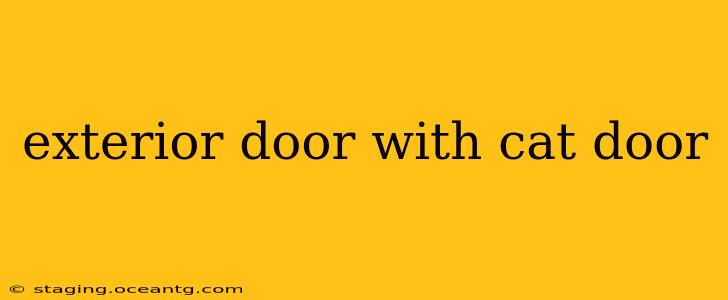Bringing your feline friend in and out without constantly opening the door yourself is a dream for many cat owners. An exterior door with a cat door offers the perfect solution, providing convenience and freedom for your cat while maintaining home security. But choosing the right door can be tricky. This guide will walk you through everything you need to know about exterior doors with integrated cat flaps, helping you select the perfect one for your home and your cat.
What are the different types of exterior doors with cat flaps?
There's a surprising variety in the market! You can find cat flaps pre-installed in ready-to-hang doors, or you can opt to install a cat flap into an existing exterior door.
-
Pre-installed Cat Doors: These doors come with the cat flap already integrated during manufacturing. This often offers a cleaner, more integrated look and may simplify installation. However, your choice is limited to the door styles and sizes offered by the manufacturer.
-
Retrofit Cat Flaps: These are separate units you install into an existing door. They offer greater flexibility in choosing your door style and allow for more customization, as you can select a flap that suits your cat's size and your door material. However, installation can be more complex, potentially requiring more specialized tools or even professional assistance.
-
Different materials: You'll encounter exterior doors (and their integrated or retrofit cat flaps) made from various materials, including wood, fiberglass, and steel. Each material has its own pros and cons regarding durability, insulation, and ease of installation.
What size cat door do I need?
Choosing the right size cat flap is crucial. Too small, and your cat might struggle; too large, and you compromise security. Measure your cat's height and width at their widest points, then add a couple of inches to allow for comfortable passage. Consider also your cat's breed and size – some breeds are significantly larger than others.
How secure are exterior doors with cat flaps?
Security is a major concern when installing a cat flap in an exterior door. Many modern cat flaps address this with features like:
-
Locking Mechanisms: Many models offer a locking mechanism, allowing you to close the flap at night or when you're away, preventing unwanted access.
-
Multiple Locking Positions: Some even provide multiple locking positions, such as a fully locked position, a position that allows only entry, and a position allowing only exit.
-
Strong Materials: Flaps made from robust materials like toughened plastic or metal offer improved resistance to damage and attempts at forced entry.
Can I install a cat flap myself, or should I hire a professional?
Installing a retrofit cat flap can be a DIY project, but it requires some skill and the right tools. If you're not comfortable with DIY projects, hiring a professional is recommended, especially for more complex installations or if you have a valuable or intricate door. Installing a cat flap incorrectly can compromise the door's integrity and security.
What are the best materials for an exterior cat door?
The material of your exterior door significantly impacts its durability, energy efficiency, and cost. Common materials include:
-
Wood: Offers a classic look, but requires regular maintenance to prevent rot and damage.
-
Fiberglass: Durable, energy-efficient, and low-maintenance, making it a popular choice.
-
Steel: Highly durable and secure, but can be more expensive and may require extra insulation to maintain energy efficiency.
What is the best type of exterior door for a cat door?
There's no single "best" type – the ideal choice depends on your home's style, your budget, and your personal preferences. Consider the factors mentioned above, such as security, material durability, and insulation, when making your decision.
How do I maintain an exterior door with a cat flap?
Regular maintenance is key to ensuring your door and cat flap remain functional and secure. This includes:
- Cleaning the flap regularly: Removing dirt and debris prevents jams and ensures smooth operation.
- Checking for damage: Regularly inspect the flap and the door frame for any signs of wear and tear.
- Lubricating moving parts: Keep the mechanism working smoothly with occasional lubrication.
By carefully considering these factors, you can choose and install an exterior door with a cat door that provides both convenience for your cat and peace of mind for you. Remember to prioritize security and choose a high-quality product from a reputable supplier.
